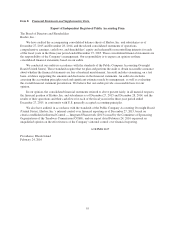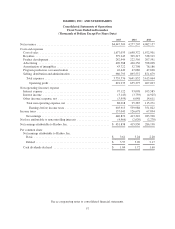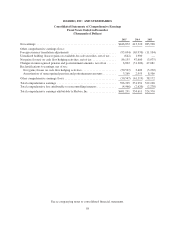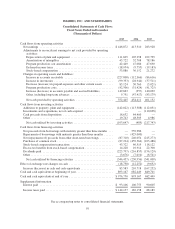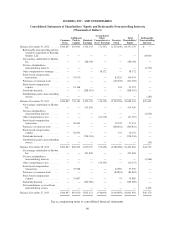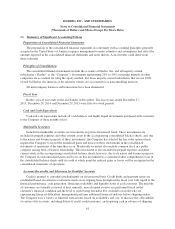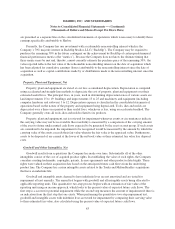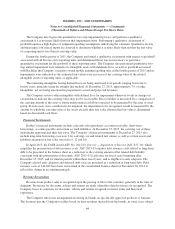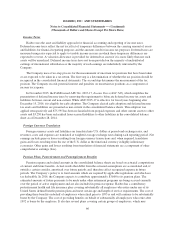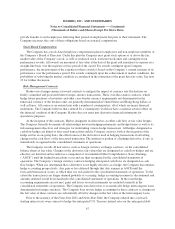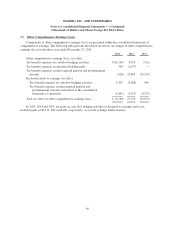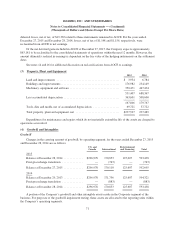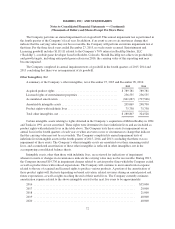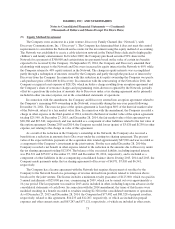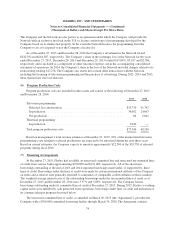Hasbro 2015 Annual Report Download - page 75
Download and view the complete annual report
Please find page 75 of the 2015 Hasbro annual report below. You can navigate through the pages in the report by either clicking on the pages listed below, or by using the keyword search tool below to find specific information within the annual report.
HASBRO, INC. AND SUBSIDIARIES
Notes to Consolidated Financial Statements — (Continued)
(Thousands of Dollars and Shares Except Per Share Data)
The Company may bypass the quantitative two-step impairment process and perform a qualitative
assessment if it is not more likely than not that impairment exists. Performing a qualitative assessment of
goodwill requires a high degree of judgment regarding assumptions underlying the valuation. Qualitative factors
and their impact on critical inputs are assessed to determine whether it is more likely than not that the fair value
of a reporting unit is less than its carrying value.
During the fourth quarter of 2015, the Company performed a qualitative assessment with respect to goodwill
associated with all but one of its reporting units and determined that it was not necessary to perform a
quantitative assessment for the goodwill of these reporting units. The Company also performed quantitative two-
step annual impairment tests related to its intangible assets with indefinite lives, as well as goodwill associated
with Backflip, the Company’s majority owned mobile gaming reporting unit, in the fourth quarter of 2015 and no
impairments were indicated as the estimated fair values were in excess of the carrying value of the related
intangible assets or reporting units, as applicable.
The remaining intangibles having defined lives are being amortized over periods ranging from four to
twenty years, primarily using the straight-line method. At December 27, 2015, approximately 7% of other
intangibles, net are being amortized in proportion to actual and projected revenues.
The Company reviews other intangibles with defined lives for impairment whenever events or changes in
circumstances indicate the carrying value may not be recoverable. Recoverability is measured by a comparison of
the carrying amount of the asset to future undiscounted cash flows expected to be generated by the asset or asset
group. If such assets were considered to be impaired, the impairment to be recognized would be measured by the
amount by which the carrying value of the assets exceeds their fair value wherein that fair value is determined
based on discounted cash flows.
Financial Instruments
Hasbro’s financial instruments include cash and cash equivalents, accounts receivable, short-term
borrowings, accounts payable and certain accrued liabilities. At December 27, 2015, the carrying cost of these
instruments approximated their fair value. The Company’s financial instruments at December 27, 2015 also
include long-term borrowings (see note 9 for carrying cost and related fair values) as well as certain assets and
liabilities measured at fair value (see notes 9, 12 and 16).
In April 2015, the FASB issued ASU No. 2015-03, Interest — Imputation of Interest (ASC 835-30), which
simplifies the presentation of debt issuance costs. ASU 2015-03 requires debt issuance costs related to long-term
debt to be presented in the balance sheet as a reduction to the carrying amount of the related debt liability,
consistent with the presentation of discounts. ASU 2015-03 is effective for fiscal years beginning after
December 15, 2015, and for interim periods within those fiscal years, and is eligible for early adoption. The
Company elected early adoption and deferred debt costs are presented as a reduction of long-term debt. Debt
issuance costs of $14,042 have been reclassified in the consolidated balance sheet for December 28, 2014 to
reflect this change in accounting principle.
Revenue Recognition
Revenue from product sales is recognized upon the passing of title to the customer, generally at the time of
shipment. Provisions for discounts, rebates and returns are made when the related revenues are recognized. The
Company bases its estimates for discounts, rebates and returns on agreed customer terms and historical
experience.
The Company enters into arrangements licensing its brands on specifically approved products or formats.
The licensees pay the Company royalties based on their revenues derived from the brands, in some cases subject
64



